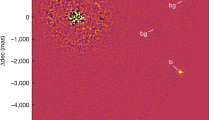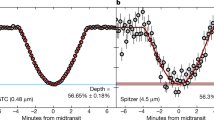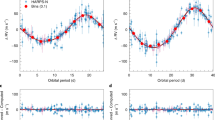Abstract
FOLLOWING the first report1 of an object of planetary mass orbiting a pulsar, Wolszczan and Frail2 have now reported the even more surprising discovery of two planet-size companions in orbit around the nearby millisecond pulsar PSR1257+12. The orbital periods of the two planets are about 98 days and 67 days, very close to a 3:2 ratio. Here we point out that, because of this near commensurability, the mutual gravitational perturbations of the two planets should produce not only small secular changes, but also larger periodic changes in their orbital elements. In particular, we find that changes in the eccentricities and orbital periods should become measurable within a few years. Such a measurement would help determine the three masses in the system and the inclinations of the orbits. More importantly, a detection of these changes, if they accord with the theoretical predictions presented here, would provide irrefutable confirmation that the periodic residuals observed by Wolszczan and Frail are indeed caused by orbiting planets, rather than some other effect. For the single planet-size object previously reported1 around the pulsar PS R1829–10, there is no dynamical test analogous to the one proposed here to confirm the planetary interpretation.
This is a preview of subscription content, access via your institution
Access options
Subscribe to this journal
Receive 51 print issues and online access
$199.00 per year
only $3.90 per issue
Buy this article
- Purchase on Springer Link
- Instant access to full article PDF
Prices may be subject to local taxes which are calculated during checkout
Similar content being viewed by others
References
Bailes, M., Lyne, A. G. & Shemar, S. L. Nature 352, 311–313 (1991).
Wolszczan, A. & Frail, D. A. Nature 355, 145–147 (1992).
Shapiro, S. L. & Teukolsky, S. A. Black Holes, White Dwarfs, and Neutron Stars (Wiley, New York, 1983).
Danby, J. M. A. Fundamentals of Celestial Mechanics (Willmann-Bell, Richmond, 1988).
Press, W. H., Flannery, B. P., Teukolsky, S. A. & Vetterling, W. T. Numerical Recipes (Cambridge University Press, Cambridge, 1986).
Brouwer, D. & Clemence, G. M. Methods of Celestial Mechanics (Academic, New York, 1961)
Dermott, S. F. & Nicholson, P. D. Nature 319, 115–120 (1986).
Malhotra, R., Fox, K., Murray, C. D. & Nicholson, P. D. Astr. Astrophys. 221, 348–358 (1989).
Gladman, B. & Duncan, M. Astr. J. 100, 1680–1691 (1990).
Author information
Authors and Affiliations
Rights and permissions
About this article
Cite this article
Rasio, F., Nicholson, P., Shapiro, S. et al. An observational test for the existence of a planetary system orbiting PSR1257 + 12. Nature 355, 325–326 (1992). https://doi.org/10.1038/355325a0
Issue Date:
DOI: https://doi.org/10.1038/355325a0
This article is cited by
-
Dynamics of Two Planets in the 3/2 Mean-motion Resonance: Application to the Planetary System of the Pulsar PSR B1257+12
Celestial Mechanics and Dynamical Astronomy (2006)
-
Evidence for free precession in a pulsar
Nature (2000)
Comments
By submitting a comment you agree to abide by our Terms and Community Guidelines. If you find something abusive or that does not comply with our terms or guidelines please flag it as inappropriate.



